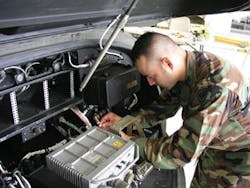Detecting a faulty electrical wire is no fun for any aircraft technicians. But imagine the task for those who take care of the Space Shuttle and its 235 miles of wire! Add the fact that physically inspecting wires is not just time-consuming, but potentially damaging to the wires themselves, and one can understand why NASA devised a noninvasive test device to do the job. Known as the Standing Wave Reflectometer (SWR), this device takes advantage of the fact that a break or short circuit within a wire will cause certain electrical signals to be reflected back to the point of origin. By measuring the time it takes for the reflection to occur, an SWR fault locator can determine the location of the problem allowing for a faster, safer, and less-damaging and disruptive repair.
Since its invention in 1999, NASA has built its own handheld SWR fault locators for inspecting the ships’ electrical and signal distribution systems. Given the noninvasive nature of this technology, it was only a matter of time before it was commercialized. And it has been done by Eclypse International Corp. (www.eclypse.org) of Corona, CA.
A developer and manufacturer of aircraft test equipment, Eclypse licensed the patented SWR technology from NASA, then used it with the help of SWR inventor Dr. Pedro Medelius to create a more robust, user-friendly, and affordable SWR fault locator called the ESP. It comes packaged in a bright yellow handheld case with an LCD display; numeric keypad, Test and Menu buttons, and various test leads.
Today, this invention is being used by the Department of Defense. But don’t expect to find it readily available on your local shop floor. Despite the ESP’s proven capabilities, the FAA has not recommended this technology for commercial/civil use.
The nitty-gritty
At first glance, the Eclypse ESP handheld seems a bit Star Trekish. It seems hard to believe that this small device, with its single pair of positive/negative test leads, would be capable of accurately locating faults in an aircraft’s wiring harness.
Yet it can do just that, according to tests conducted by Australia’s Defence Technical Information Center (DTIC). In a 2003 DTIC report titled ‘An Evaluation of the Eclypse ESP Hand-Held Standing Wave Reflectometer,’ author Jim Quinn reported that the Eclypse ESP “was shown to operate successfully and quickly on coaxial cables, twisted pairs, shielded cables, and pairs of wires within multi-wire looms. For aircraft wire management this offers an improved fault location capability prior to repairs on the flight line or during maintenance.” (The entire DTIC report can be viewed online at http://stinet.dtic.mil/oai/oai?verb=getRecord
&metadataPrefix=html&identifier=ADA415974.)
So how does the Eclypse ESP handheld work its magic? “The Eclypse ESP exploits the fact that in many cases the cables [in an aircraft] are electromagnetic transmission lines which propagate high frequency electrical signals,” Quinn explains; whether the wires in question are coaxial cables, twisted pairs, or wires bundled together in a loom. “The device utilizes the fact a short circuit or an open circuit on a transmission line is a point of reflection for a signal injected by the device. By transmitting signals over a frequency range the device can determine the type of fault and its distance along the wires.”
“What this means is that a technician can use the ESP or the higher-end ESP+ to detect a fault in an aircraft that is, say 114 feet away from their position,” says Christopher Teal, Eclypse’s marketing director. “You just clip the positive lead onto the wire in question, and the negative either to an adjacent wire or the airframe. The signals themselves cover from approximately 10 to 50 MHz. It only takes a few seconds for the device to send them out and display back the location of the fault, within 6 inches on either side of its actual location.”
Teal’s qualification reflects the DTIC’s conclusion that, although “an effective tool for determining the distance to a known short circuit or an open circuit,” the Eclypse ESP is not perfect. “The accuracy of the result depends on using a relative velocity setting which is appropriate for the cable under test,” Quinn writes. “Some impedance settings can produce erroneous results when testing cables with a short circuit. Intervening connectors or terminal post connections may bias the results for a particular electrical cable run.” Still, when compared to the time, effort, and potential damage caused by exposing open wiring first and then trying to find the fault, the ESP is an excellent place to start.”
The Eclypse ESP can operate on wires up to 1,000 feet long in temperatures ranging from -20 C to +60 C, and can store 99 different preset parameters for testing different kinds of wire. It weighs 1 pound, 3 ounces, and is about the size and shape of a scientific calculator.
The ESP in action
Not surprisingly, the Eclypse ESP has found its way into the Department of Defense (DoD), with thousands of the units already being deployed by the Army, Air Force, and Navy. In particular, ESPs are being used in battlefield locations in Afghanistan and Iraq, where the need for fast problem diagnosis in rough conditions makes it an ideal frontline tool. Besides in-theater usage, Eclypse ESPs are being included in DoD’s Battlefield Damage Assessment & Repair (BDAR) Kits. These are small, portable kits included on military aircraft such as the UH-60 Blackhawk helicopter, to allow fast repairs during unexpected AOG incidents.
“In Afghanistan and Iraq, many of the aircraft take constant fire from AK-47s and RPGs on the ground,” says Teal. “The pilot and crew are only protected by a floor plate of steel, and the rest of an aircraft is vulnerable to small arms fire. It damages the wiring bundles inside, causing shorts and critical system failures. In these cases where an aircraft is downed away from its base, the BDAR can be used to assess whether the ship can be brought back into action quickly, or whether it should be destroyed to keep it out of enemy hands. A technician equipped with an ESP can often troubleshoot an electrical failure and get the ship patched together fast, so that it and the crew can return to fight another day.”
Not FAA-recommended
Given its NASA heritage and the DoD’s embrace of the Eclypse ESP, one would expect the FAA to follow suit. After all, SWR technology was developed to prevent another TWA 800 in-flight fuel tank explosion, in which “the most likely [cause] was a short circuit outside of the CWT that allowed excessive voltage to enter it through electrical wiring associated with the fuel quantity indication system,” says the NTSB report on the accident.
Yet despite this fact, the FAA has not recommended use of tools like the Eclypse ESP for commercial and civil MRO use. According to Teal, the FAA has publically stated that nondestructive testing tools “are not ready for prime time use.” Airlines have taken this message to mean that the ESP is not up to the job, he adds.
So what does the FAA have to say? According to FAA spokesperson Les Dorr, “The FAA does not ‘approve’ test equipment. A manufacturer or repair station may develop production or maintenance procedures and identify the appropriate test equipment, when necessary. As far as we know, no civil aircraft manufacturers or repair stations have instituted procedures that call for the use of the Eclypse ESP.”
Meanwhile, a January 2007 report jointly issued by the FAA and the U.S. Department of Transportation titled, “Commercial Off-the-Shelf Wiring System Diagnostics Evaluations “ (available online at www.tc.faa.gov/its/worldpac/techrpt/ar0661.pdf) had this to say about the FAA’s testing of the device: “The ESP proved to be a very useful tool for open and short defect detection. However, the location detection capability was somewhat limited, and it is not clear that the limitations were entirely due to VOP [velocity of propagation] issues.”
“We’re somewhat frustrated with the FAA not validating or stating acceptance use of the ESP for commercial/civil use, when NASA and DoD clearly have so much proven faith in it,” says Christopher Teal. “Granted, it is not a perfect device, and we have never said that it was; no test equipment is. But as a low-cost fault location tool, the ESP is a profoundly useful device, and one that could make a real difference on the MRO shop floors of America.”
The bottom line: For MROs, the Eclypse ESP could be a highly valuable fault location tool, with or without the FCC’s recommendation. Certainly NASA and DoD have faith in this technology.

